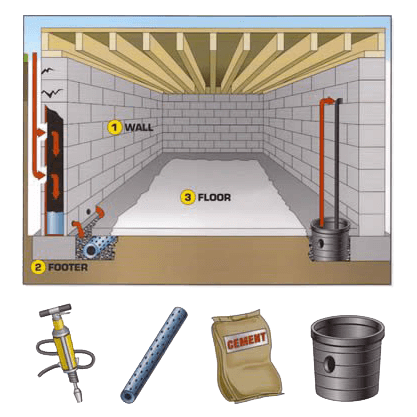Basement Waterproofing Toronto: Guard Your Basement from Future Leaks
Basement Waterproofing Toronto: Guard Your Basement from Future Leaks
Blog Article
Proven Strategies for Effective Basement Leak Fixing and Avoidance
Dealing with basement leaks efficiently needs both a critical method and an understanding of proven strategies. The first step includes a meticulous inspection to pinpoint the precise resources of dampness invasion. This is complied with by employing premium sealants and hydraulic concrete to seal cracks, to name a few repair work approaches. Prevention is equally critical; keeping proper water drainage systems and regulating indoor moisture are essential parts. Consideration has to likewise be provided to ongoing monitoring and timely upkeep. What are the key methods that make sure these services not just fixing but additionally stop future leaks, eventually preserving your cellar's stability?
Identifying Basement Drip Sources
Identifying the sources of cellar leaks is an important action in effectively attending to and protecting against water damages. In addition, landscape grading that slopes in the direction of the building intensifies this issue, enabling water to move directly to the basement walls.

Necessary Devices and Products
Repairing basement leakages properly requires a well-stocked toolkit and the best products to make certain long-lasting options. Initially, an important tool is a high-grade caulking weapon, which allows for accurate application of sealants around fractures and joints. A durable hammer and sculpt are likewise essential for removing loose concrete or particles from the influenced locations. For bigger splits, a concrete patching substance is indispensable, providing a durable fill that withstands pressure and moisture.
A reliable wet/dry vacuum cleaner is vital for at first eliminating water from the cellar, enabling a completely dry functioning atmosphere. Additionally, a dampness meter is essential to analyze the moisture levels prior to and after repair work, ensuring that dampness problems are sufficiently dealt with. State-of-the-art waterproofing sealants or membrane layers are vital for avoiding future leakages, developing a robust obstacle versus water invasion.
Safety must not be overlooked; safety gear such as handwear covers, goggles, and a mask are important to safeguard versus dust and chemicals. Lastly, an energy knife and cord brush are invaluable for prepping surface areas to make certain optimal attachment of spots and sealers. These materials and devices lay the foundation for effective cellar leakage repair work, improving toughness and resilience against future water damage.
Step-by-Step Fixing Techniques
With the needed devices and materials available, resolving cellar leaks involves a methodical strategy to ensure efficient repair services. Begin by recognizing the leak's source, which frequently calls for a thorough evaluation of wall surfaces, floorings, and possible entrance factors for moisture. Once identified, clean the affected area diligently to remove dirt, debris, and any loose material that could hamper the fixing procedure.
Following, if the leakage stems from a split, use a sealant specifically developed for concrete surfaces. Apply the sealant with accuracy, guaranteeing it penetrates deep into the crevice to form a watertight bond. For larger fissures, take into consideration utilizing hydraulic cement, which broadens as it sets, providing a durable seal.
In circumstances where the leak results from damaged joints or pipe infiltrations, make use of an adaptable sealer that can accommodate minor motions and changes. Apply it generously to cover the whole joint circumference, guaranteeing total coverage.
Preventive Actions to Take Into Consideration
Preventive maintenance is crucial in guarding your cellar from future leaks and possible water view it now damages. Executing efficient safety nets can substantially reduce the likelihood of sustaining expensive repairs. One of the key methods involves making certain appropriate outside drain systems. This entails keeping practical and tidy rain gutters and downspouts, routing water away from the structure by extending downspouts a minimum of five feet from the framework. Additionally, rating the landscape to slope far from the structure can avoid water buildup around your home.
Securing potential entrance factors is another crucial safety net. Using water-proof sealant to the exterior and interior walls of your basement can produce a reliable obstacle against wetness seepage. Examining and repairing any noticeable splits in the structure promptly is important to avoid minor issues from growing out of control right into considerable issues.
Setting up a sump pump system is a positive technique to managing water ingress, especially for homes positioned in locations vulnerable to hefty rains or high water tables. A sump pump can efficiently remove built up water, preventing it from reaching critical degrees. Ultimately, making certain that basement windows and doors are appropriately secured and fitted with home window wells can additionally safeguard against undesirable water entrance.
Monitoring and Maintenance Tips
Normal monitoring and upkeep of your cellar are vital to ensure its long-term honesty and performance - basement crack repair Toronto. Carrying out periodic examinations can assist identify concerns before they rise right into considerable problems. Begin by checking out walls and floorings for fractures or indicators of moisture seepage. Dealing with tiny fractures quickly with proper sealants can stop water from leaking in, avoiding possible damages.
Check the basement's moisture degrees frequently, as too much wetness can cause mold and mildew and mildew development. Utilize a hygrometer to preserve moisture degrees between 30-50%, and think about setting up a dehumidifier if essential. Ensure that sump pumps are functional, inspecting them semi-annually and evaluating them by pouring water right into the sump pit to validate activation.

Routinely keeping these elements not only safeguards your cellar but additionally extends its capability, protecting your financial investment and guaranteeing a completely dry, usable room for many years to come.
Conclusion
In conclusion, the effective repair and prevention of basement leakages demand a thorough strategy including complete assessment, suitable sealing materials, and critical drainage here are the findings solutions. Regular surveillance of moisture degrees, paired with the setup of sump pumps in vulnerable locations, better fortifies my company the basement versus leaks.
What are the essential practices that make certain these options not only repair however likewise prevent future leakages, eventually preserving your cellar's integrity?
Recognizing the resources of basement leakages is an important step in properly attending to and avoiding water damage. These materials and devices lay the groundwork for reliable basement leakage repair work, boosting toughness and resilience versus future water damage.
With the needed tools and materials at hand, addressing basement leaks includes a systematic method to ensure efficient fixings.Preventive upkeep is crucial in guarding your basement from future leaks and possible water damages.
Report this page